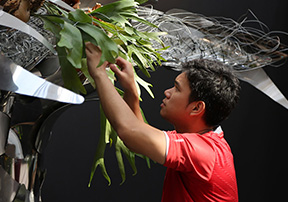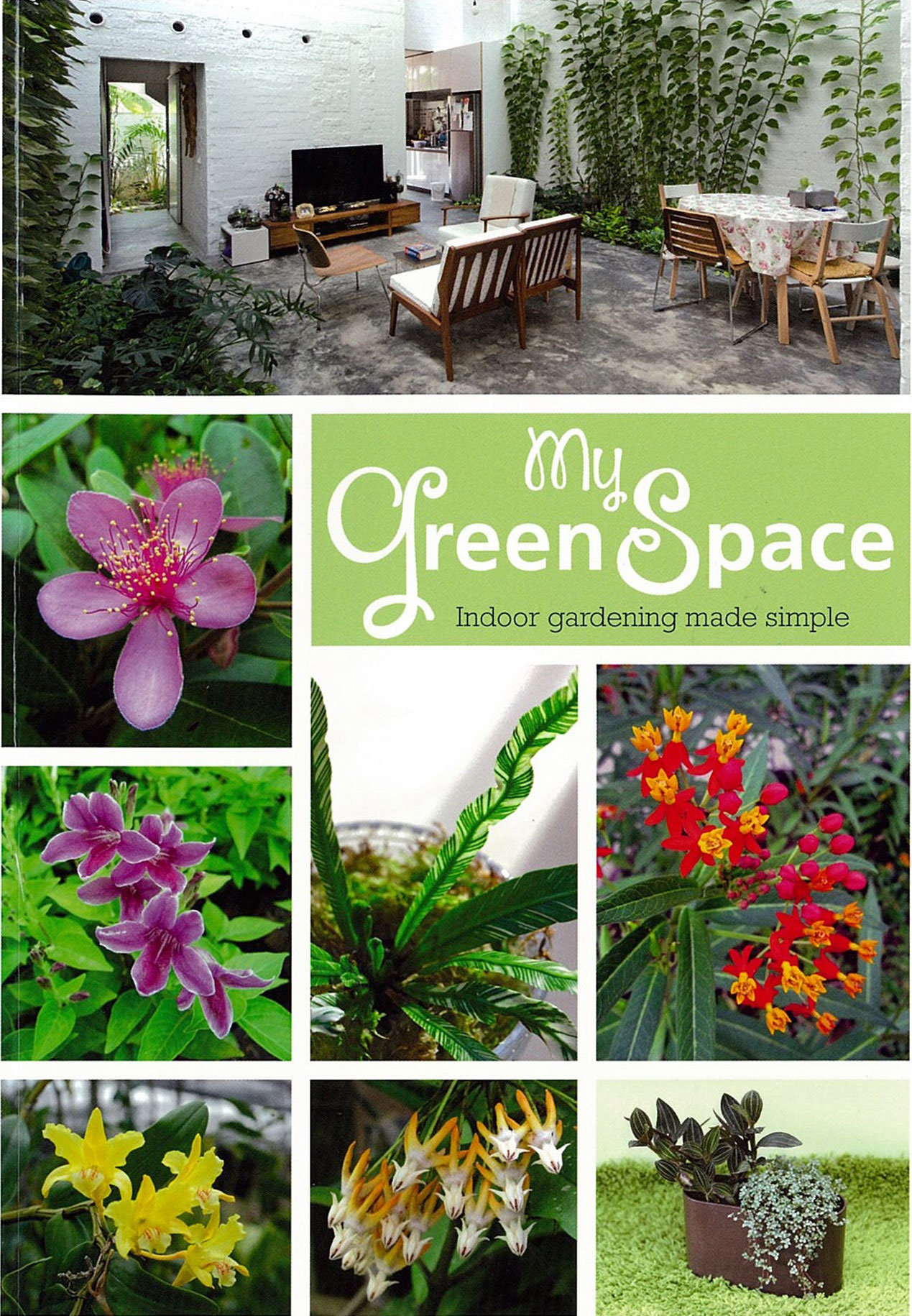Singapore, while small in size, actually boasts a mind-boggling array of 2,200 plant species on record. Still, not many people are familiar with our native species of plants.
This could be because many of these plants do not put on spectacular floral displays as compared to, say, the introduced Bougainvillea that greets locals and visitors alike on the road around Changi Airport. Hence, our native species often end up with labels such as ‘bunches of leaves’ or ‘wild grasses’, even amongst keen gardeners.
This is one of the reasons why the Native Plant Squad (NPS), comprising staff volunteers in NParks, started creating planted plots in HortPark that showcase a selection of some of our most attractive native species in a garden setting. Today, the Native Plant Squad Garden features more than 60 species of native plants.
What’s particularly special about these two plots is that they host many plants that were actually salvaged by NPS members, as well as researchers from the Singapore Botanic Gardens. The mother plants, seeds or cuttings were collected or ‘rescued’ from areas that were being developed. These were then painstakingly nurtured in the Pasir Panjang Nursery for many months before they were planted in the plots, or prepared for eventual re-introduction into our forests, parks or gardens.
A number of the species planted in the plots have also been featured in landscapes for the very first time, and some species can even do well in home gardens, including those in high-rise apartments!
What other surprises can you find in the native plant plots? We introduce 10 rather attractive species here, but come visit our Garden to find out more!
|
Aeschynanthus parvifolius
Lipstick Plant
If this plant looks familiar, it is because this is one of the species that is commonly sold as a potted plant by commercial nurseries. In the wild, it grows as an epiphyte – climbing on tree branches or trunks.
It has rather fleshy leaves that are neatly arranged along its long, trailing stems, and bright red flowers that appear at the tips of the stem. It does best in very bright, indirect light or morning sun and when watered regularly. This genus of plants takes its common name from the bright red flower buds that resemble lipsticks.
|
 (Photographed by: Tamako Kobayashi, Copyright © NParks Flora&FaunaWeb)
(Photographed by: Tamako Kobayashi, Copyright © NParks Flora&FaunaWeb) |
|
Alpinia aquatic
Aquatic Alpinia, Aquatic Ginger
As the scientific name suggests, this species of ginger can actually grow partially submerged in water! In its native habitat, this species can be found growing in waterlogged areas, near streams or water bodies. Still, it is a surprisingly tolerant species and can withstand some dryness for short periods.The small, pinkish-white flowers appear at the end of the growing tips of the ‘stems’, and these are followed by numerous small dark purplish black fruits. This species can be grown under full sun or partial shade.
|
 (Photographed by: Vicky Lim Yen Ngoh, Copyright © NParks Flora&FaunaWeb)
(Photographed by: Vicky Lim Yen Ngoh, Copyright © NParks Flora&FaunaWeb) |
|
Cheilocostus globosus
Orange Spiral Ginger, Orange Crepe Ginger
This tall, much branched relative of the edible ginger was thought to be locally extinct before two populations were rediscovered by Dr Jana Skornickova, a researcher from the Singapore Botanic Gardens. This species is easy to cultivate, fast-growing and can grow up to a height of 1.5 m. The bright orange red flowers are quite large, and are borne close to the ground, so look down if you want to spot the exotic-looking blooms!
|
 (Photographed by: Lily Chen, Copyright © NParks Flora&FaunaWeb)
(Photographed by: Lily Chen, Copyright © NParks Flora&FaunaWeb) |
|
Dianella ensifolia
Common Dianella
This plant could be why many people think of native plants as merely ‘wild grass’. When not in flower, this relatively short plant resembles a clump of grass with long leaves. But when it is ready to bloom, it sends out a long stem with dozens of small, star-shaped flowers that are a striking blue-violet in colour.But that is not the only attractive feature of this species: it often bears many berries that are a deep shade of cobalt blue. Apart from its attractive attributes, the Common Dianella is also very adaptable; it can grow in a wide range of soil and light conditions.
|
 (Photographed by: Ang Wee Foong, Copyright © NParks Flora&FaunaWeb)
(Photographed by: Ang Wee Foong, Copyright © NParks Flora&FaunaWeb) |
|
Dillenia excelsa
Simpoh Lak
The flowers of this plant may bring back memories of National Service for some park visitors! This is because the Simpoh Lak is a relative of a much smaller Simpoh Ayer or Dillenia suffructicosa, which is usually cut down and used as camouflage during military training!The similarities however stop at the colour of the flowers – the Simpoh Lak is a much taller tree with a columnar crown, and the flowers have a deep red centre. This species can flower even at a moderate height of about 1.5 to 1.8 m tall, and will easily fit into small gardens. It grows best in full-sun and should be watered regularly. The flowers are frequented by bees.
|

 |
|
Freycinetia javanica flower
This climber is in the same family as our edible Pandan (Pandanus amaryllifolius). It is one of a number of species that has been featured in landscapes for the first time. In the wild, this species climbs onto tree trunks or over large rocks and boulders. The flowers are grouped into separate male and female inflorescences; the male inflorescence is reddish-orange, and is more attractive than the female.
|

 (Photographed by Ang Wee Foong, Copyright © NParks Flora&FaunaWeb) (Photographed by Ang Wee Foong, Copyright © NParks Flora&FaunaWeb) |
|
Ixora congesta
Malayan Ixora, Jarum Jarum
Unlike the dozens of hybrids from the same genus that require full sun to bloom, this species has an added advantage – it thrives and blooms in areas with very bright, indirect light. This woody shrub can grow up to 1.8 to 2 m tall, and bears many clusters of bright to dark orange flowers during the blooming seasons. As the vernacular name ‘Jarum Jarum’ suggests, the unopened flower buds resemble a bunch of needles! The flowers attract butterflies, so it is a great plant to grow if you like to admire butterflies.
|
 |
|
Hoya latifolia
Wax Flower
Hoya latifolia has the largest leaves amongst our climbing Wax Flower species, with some growing as large as a small dessert plate or the size of an adult’s hand! Flowering is often observed during the cooler parts of the year, during the monsoon periods. The pale pink flowers have a waxy look (hence the common name) and are fragrant. It is easy to grow and does well even when potted. Plants of this species were salvaged and contributed by Dr Michele Rodda, a Hoya expert from the Singapore Botanic Gardens.
|
 (Photographed by: Lily Chen, Copyright © NParks Flora&FaunaWeb)
(Photographed by: Lily Chen, Copyright © NParks Flora&FaunaWeb) |
|
Portulaca pilosa subsp. pilosa (race tuberosa)
Seashore Purslane
If you are looking for a succulent native to Singapore, the Seashore Purslane is a salt spray and drought-tolerant species that is found on our shores. Under ideal conditions, this tiny species will form large mats on the substrate. Grow this species in well-drained soil, in full sun, for the best results.
|
(Photographed by: Ang Wee Foong, Copyright © NParks Flora&FaunaWeb) |
|
Tarenna fragrans
River Tarenna
One of the most attractive native species that we have planted till date is the River Tarenna. As the scientific name suggests, the flowers are delightfully fragrant. This small low-branching tree can grow up to 2.5 m tall, and can tolerate being in full sun or semi-shade. When in season, it flowers profusely, and the entire plant can be covered with flowers.
|

 |
Visit www.florafaunaweb.nparks.gov.sg to learn more about these featured plants,
The Native Plant Squad Garden is located in HortPark, next to the orchid display by the Orchid Society of South East Asia (OSSEA), and diagonally opposite the vegetable garden.
The Native Plant Squad Garden in HortPark is brought to you by the Hort Standards & Plant Information Unit and Pasir Panjang Nursery, in conjunction with the National Biodiversity Centre Terrestrial Branch, with contributions from the Singapore Botanic Gardens.
Text by Erika Halim and Tamako Kobayashi
Photos from Flora & Fauna Web


 (Photographed by: Tamako Kobayashi, Copyright © NParks Flora&FaunaWeb)
(Photographed by: Tamako Kobayashi, Copyright © NParks Flora&FaunaWeb) (Photographed by: Vicky Lim Yen Ngoh, Copyright © NParks Flora&FaunaWeb)
(Photographed by: Vicky Lim Yen Ngoh, Copyright © NParks Flora&FaunaWeb) (Photographed by: Lily Chen, Copyright © NParks Flora&FaunaWeb)
(Photographed by: Lily Chen, Copyright © NParks Flora&FaunaWeb) (Photographed by: Ang Wee Foong, Copyright © NParks Flora&FaunaWeb)
(Photographed by: Ang Wee Foong, Copyright © NParks Flora&FaunaWeb)


 (Photographed by Ang Wee Foong, Copyright © NParks Flora&FaunaWeb)
(Photographed by Ang Wee Foong, Copyright © NParks Flora&FaunaWeb)
 (Photographed by: Lily Chen, Copyright © NParks Flora&FaunaWeb)
(Photographed by: Lily Chen, Copyright © NParks Flora&FaunaWeb)




Have views or comments on this article? Let us know via this form. If you would like to give us feedback on any other areas relating to our parks and gardens, please submit via https://www.nparks.gov.sg/feedback